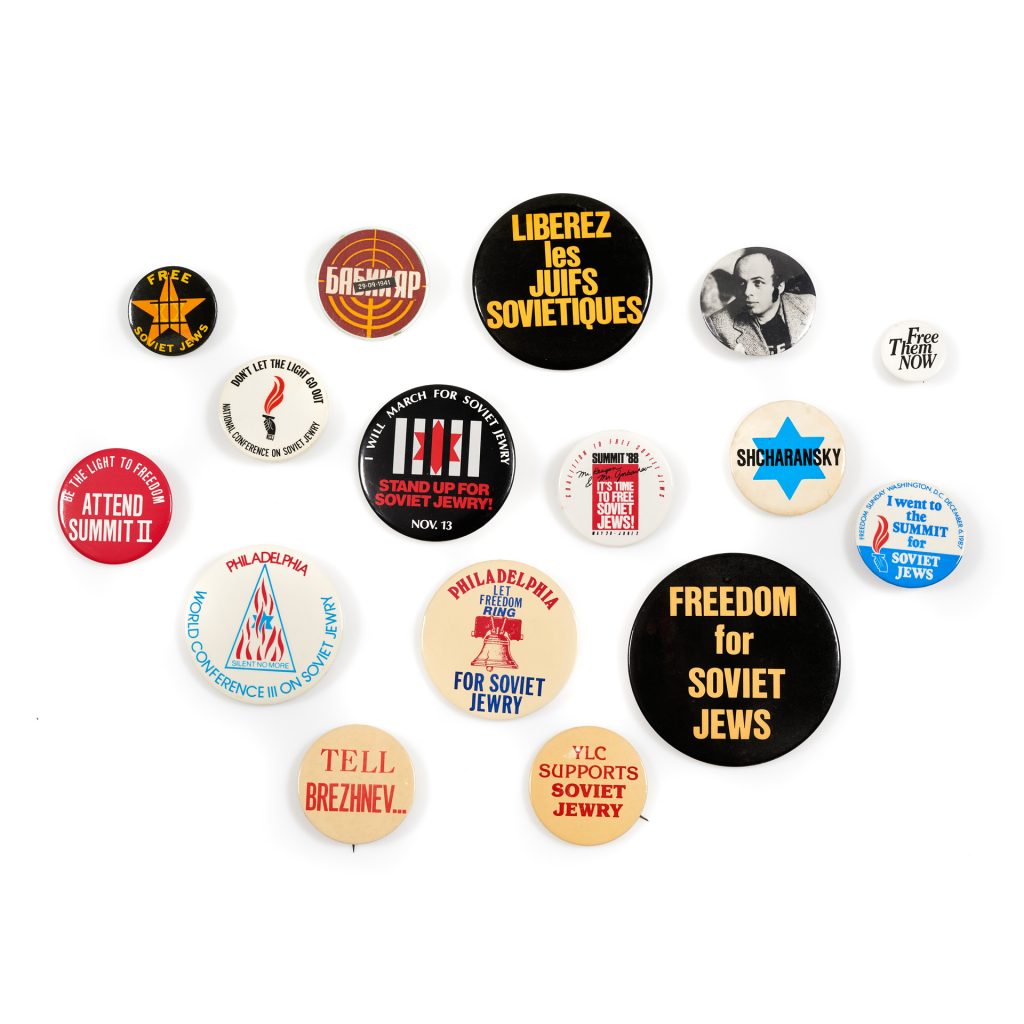Lapel Pins and Medallion Marking support of Prisoners of Zion,
and Objection to the Iron Curtain Policy, which Banned Jewish
Immigration to Israel
USA, 1974-1989
Printed metal, plastic
Gift of Constance and Joseph Smukler, Soviet Jewry Legacy
Must Know
These soviet Jewry pins and medallions were activism symbols that marked the Soviet Jewry movement to open up the Soviet gates to Jewish emigration. During the Iron Curtain (1945-1991), immigration out of the Soviet Union was limited and tightly controlled. The ban on Jewish immigration was lifted in 1971 and followed by the 1970s Soviet Union Aliyah.
The 16 buttons and 1 star of David Pendant include:
Stand Up for Soviet Jewry Button
Freedom for Soviet Jewry Button
Philadelphia Let Freedom Ring for Soviet Jewry Button
Liberez les Juifs Button
Shcharnasky Button
Tell Brezhnev Button
Free Them Now Button
29-09-1941 Button
Summit ’88 Button
Free Soviet Jews Yellow Star Button
Photo of Natan Button
1987 I Went to the Summit for Soviet Jews Button
Philadelphia World Conference III on Soviet Jewry Button
Be the Light to Freedom Button
Don’t let the Light Go Out Button
YLC Supports Soviet Jewry Button
Gold Star of David Pendant
Joseph and Connie Smukler, the owners of these artefacts, were Soviet Jewish activists from Philadelphia, USA.
Gift of Constance and Joseph Smukler, Soviet Jewry Legacy
More Info
During the Iron Curtain, many Jews suffered systematic and institution antisemitism. Soviet rules on religious activity prevented Jews from engaging in Jewish cultural and religious life, which largely contributed to the reasoning behind their denied permission to immigrate away from the ISSR. Soviet Jews who applied for an exit visa to leave the Soviet Union and were denied were called refusnik (deriving from the refusal haded down to Jews by Soviet Union authorities). Typically the reason behind the rejection was the alleged association with Soviet state secretes – Jews were viewed to be a security liability or possible traitors. Nowadays the term ‘refusnik’ is used in the english language as a person who refuses to do something, especially by way of protest.
Another way Soviet Jews suffered from anti-semitism in the time of the Iron Curtain was direct imprisonment or deportation when accused of being involved in Jewish activity. Pro-Israel activity or attempts to encourage immigration to Israel were prohibited in communist bloc countries and in the Soviet Union. Soviet Jews who were attacked based off their punitive Zionist activities were called Prisoners of Zion. From 1922, prisoners of Zion living in Israel are entitled to various benefits from the State.
Joseph and Connie Smukler who donated these pins and medallions to be exhibited at Anu Museum were very involved in the Soviet Jewry movement. Fighting to liberate Soviet Jews during the 1970s 1980s, the Smuklers helped many prisoners of Zion and refusniks to find freedom in the United States and Israel. Smulker was the co-chair of the first National Conference on Soviet Jewry that was held in Philadelphia as well as being active members in the Soviet Jewry Communist Relations Council of Greater Philadelphia.

